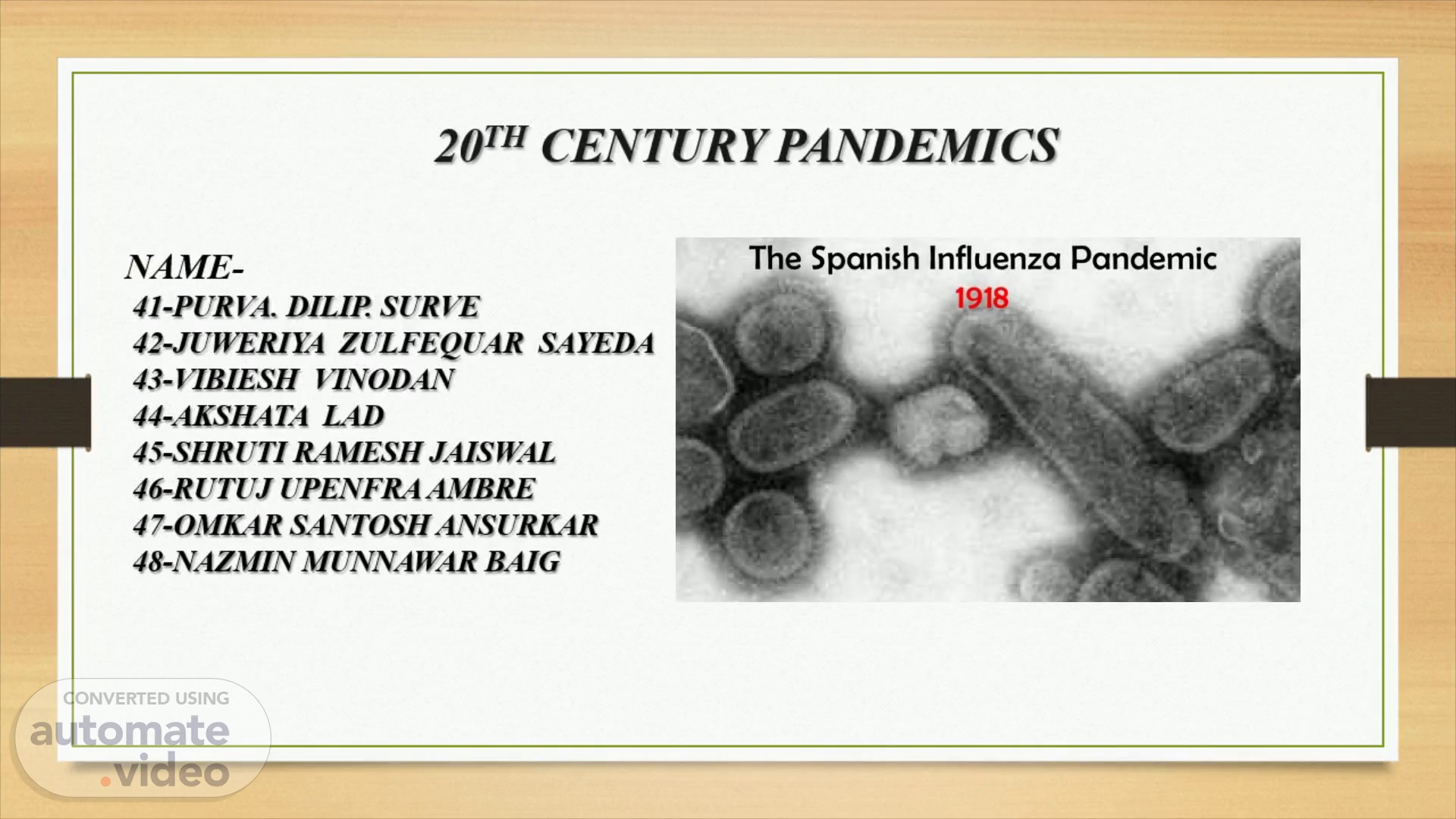
PowerPoint Presentation
Scene 1 (0s)
20 TH CENTURY PANDEMICS. NAME- 41-PURVA. DILIP. SURVE 42-JUWERIYA ZULFEQUAR SAYEDA 43-VIBIESH VINODAN 44-AKSHATA LAD 45-SHRUTI RAMESH JAISWAL 46-RUTUJ UPENFRA AMBRE 47-OMKAR SANTOSH ANSURKAR 48-NAZMIN MUNNAWAR BAIG.
Scene 2 (15s)
The 1918 influenza pandemic was the most severe pandemic in recent history. It was caused by an H1N1 virus with genes of avian origin. Although there is not universal consensus regarding where the virus originated, it spread worldwide during 1918-1919 ..
Scene 3 (44s)
1918 Flu Pandemic The 1918 flu pandemic was an unusually severe and deadly influenza pandemic that spread across throughout the world. Most victims of the flu were healthy young adults, in contrast to most influenza outbreaks which would affect the young, elderly, or weak. The pandemic lasted from June 1917 to December 1920. The flu spread throughout the world. Between 50 and 100 million died. An estimated 50 million people died of the disease. Some 500 million were infected by this flu..
Scene 4 (1m 19s)
Warl. WORLD WAR 1. The flu spread quickly when soldiers carried the flu with them wherever they traveled. A theory is that the stresses of combat increased the soldiers vulnerability to the virus. Modern transportation made it easier to spread the flu. the flu had killed 57,000 American soldiers which is 4000 more than those killed in the war itself. In total 25% of Americans got the virus ..
Scene 5 (1m 53s)
MEDICINE ON THE WAR FRONT IN WORLD WAR-1. There were many diseases and illnesses that formed throughout WW1. One new illness discovered during this time was Da Costa's Syndrome, which was also called Soldier's Heart. J.M. Costa described the condition as "strain or overreaction of the heart". Today, Da Costa's Syndrome is considered an anxiety disorder. Treatment for the issue is primarily behavioral, including modifications to one's lifestyle and everyday routine. Typhoid Fever was also a harmful disease during WW1. This fever was spread by ingestion of food or water contaminated by faecal matter. This disease was mainly seen in trench life and was mainly associated with poor hygiene and poor sanitation. Influenza was also a wide-spread virus that took over the world during the same time period as WW1.
Scene 6 (3m 1s)
Where did it come fr Tibet? Ohi an sasa.
Scene 7 (3m 12s)
What are the differences and similarities between the Spanish flu and COVID-19? The Spanish flu and COVID-19 viruses aren’t the same. They are similar in that they're both respiratory viruses spread through breathing in infected respiratory droplets. In addition, they both did and can cause acute respiratory distress syndrome (ARDS). They are also similar in the ways that governments tried to fight them:Avoiding delays in diagnosis.Efforts to develop medication.Isolation / lockdown.Protective clothing like masks and gloves.Hygiene practices like thorough hand washing ..
Scene 8 (3m 55s)
Spanish Flu Symptoms The first wave of the 1918 pandemic occurred in the spring and was generally mild. The sick, who experienced such typical flu symptoms as chills, fever and fatigue, usually recovered after several days, and the number of reported deaths was low. However, a second, highly contagious wave of influenza appeared with a vengeance in the fall of that same year. Victims died within hours or days of developing symptoms, their skin turning blue and their lungs filling with fluid that caused them to suffocate. In just one year, 1918, the average life expectancy in America plummeted by a dozen years..
Scene 9 (4m 51s)
h ories or • arme fr f Orig n genetic The virus cÅme Fort Riley; Kansas by two genetic mechanisms. It mutated inkswine • The viros humans •t The virus stär*ed T ib*BÄß to Euhope and was L—pread to trpopS cöming back to the U.S The flu was thought to have corne from Spain ecause th Vnost reliable news coverage carne from hat area, t irnage Spain was most aff ed..
Scene 10 (5m 33s)
brea r he thi aves of the flu w 9.m c mpare t. the öpgh t 'häd hi - -f r "ks oc rance„, one arch:1919 arfcfsprea.
Scene 11 (6m 5s)
PANDEMIC INFLUENZA MORTALITY IN AMERICA AND EUROPE DURIN 191B AND1919 DEATHS ALL CAUSES EACH '..VEEK EXmSSED RATE PER 1000 t k • It is estimated 50-100 million pe from the Spanish Influenza:.
Scene 12 (6m 30s)
Mortality by country • India- 17 @ion • Japan- 39 0 United S es- OO,OOO- 675,000 Britain- ;ooo — abo, oo . Canåda- Dutch East Indies Au stra I i au I O O _ Fiji-IslandsSl*40Æof the- pppulation •ANestern• Sarnoa- 22% -Entii-e villages periShedir*A1a Africa.
Scene 13 (7m 11s)
pu ' smeppt-.n Keqo„.
Scene 14 (7m 21s)
The-Irnpact The pa ldqrnicæaused large stunted omic -growth years-a • e r. eople ega. to listen to. ori s of p he pa has irhpikd alth- ch Pal Horse, Pale Ride— atherine Ann Porter The Poctor's Son— & Morrell Research and done Oda'el recreat/ng viruS! qrLreeearch and etudyi historie .tiseue saål I.
Scene 16 (8m 34s)
How was the Spanish flu prevented? There were no nationwide prevention methods in place against the Spanish flu. Some communities did put into place prevention methods that may look familiar to us today. The measures included:Isolation , or staying away from crowds of people. This included closing places like schools and gyms.Washing your hands completely and often.Wearing protection like masks and gloves.Not touching outside items like library books.Not spitting in public..
Scene 17 (9m 18s)
THANK YOU.